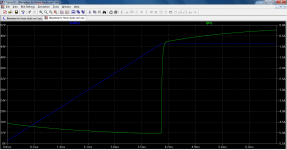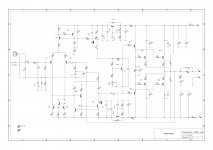I burn fuse on positive voltage of my amplifier when I turn on the power supply from empty capacitor reservoir.
I use 2x 12.000uF + 1x 10.000uF, voltage is +42V DC.
The fuse is 5A. I replace with 6,3A and 7A and it still burn. After I replace with 10A, it not burn.
I sim turn on condition on my amp. When it turn on time is 1mS, it consume 21A and then decrease to normal condition (only 160mA). If turn on time is 5mS, it consume about 5A and then decrease to normal value.
Should I reduce capacitor reservoir value?
I use 2x 12.000uF + 1x 10.000uF, voltage is +42V DC.
The fuse is 5A. I replace with 6,3A and 7A and it still burn. After I replace with 10A, it not burn.
I sim turn on condition on my amp. When it turn on time is 1mS, it consume 21A and then decrease to normal condition (only 160mA). If turn on time is 5mS, it consume about 5A and then decrease to normal value.
Should I reduce capacitor reservoir value?
Fit primary or Mains' fuse before the transformer.
This can be close rated, or standard rated.
I recommend a close rated primary fuse and this usually requires a soft start circuit to limit the starting current.
If required, fit a secondary fuse AFTER the main smoothing capacitor/s.
Fitting a secondary fuse between the transformer and the smoothing capacitor/s requires such a high current rating that virtually no extra protection, nor safety is afforded by it/them.
In my opinion high value fuses before the smoothing caps are simply a waste of money and a waste of space.
This can be close rated, or standard rated.
I recommend a close rated primary fuse and this usually requires a soft start circuit to limit the starting current.
If required, fit a secondary fuse AFTER the main smoothing capacitor/s.
Fitting a secondary fuse between the transformer and the smoothing capacitor/s requires such a high current rating that virtually no extra protection, nor safety is afforded by it/them.
In my opinion high value fuses before the smoothing caps are simply a waste of money and a waste of space.
post2 simulation result.
You have asked the simulation program the wrong question.
5.05Apk for a duration of <4ms does not blow a 5A fuse.
Check your 5A datasheet.
How long will your 5A fuse last when passing 5A?
Find the 10A fuse datasheet.
How long will the 10A fuse pass 11A?
What duration to rupture does the fuse manufacturer guarantee that the fuse will rupture for 20A and for 50A?
You have asked the simulation program the wrong question.
5.05Apk for a duration of <4ms does not blow a 5A fuse.
Check your 5A datasheet.
How long will your 5A fuse last when passing 5A?
Find the 10A fuse datasheet.
How long will the 10A fuse pass 11A?
What duration to rupture does the fuse manufacturer guarantee that the fuse will rupture for 20A and for 50A?
post2 simulation result.
You have asked the simulation program the wrong question.
5.05Apk for a duration of <4ms does not blow a 5A fuse.
Check your 5A datasheet.
How long will your 5A fuse last when passing 5A?
Find the 10A fuse datasheet.
How long will the 10A fuse pass 11A?
What duration to rupture does the fuse manufacturer guarantee that the fuse will rupture for 20A and for 50A?
I found only one type fuse on local market. I don't know the manufacturer. I think it fast blow fuse. What is about PTC reset-able fuse? Can I use it?
Hi,
Try a slow blow fuse and see it is does not blow.
OK, I will ask to local forum who sell slow blow fuse in my country.
What is the resistance of the Primary winding?
Take the mains resistance/impedance as 0.5ohm
Add these together. This is the total resistance of the primary circuit.
Now divide your Mains peak voltage by the total resistance of the primary circuit.
That is roughly the maximum peak current that can flow around your primary circuit while the transformer tries to start up.
The only cheap way to limit this start up current is to use a soft start.
Take the mains resistance/impedance as 0.5ohm
Add these together. This is the total resistance of the primary circuit.
Now divide your Mains peak voltage by the total resistance of the primary circuit.
That is roughly the maximum peak current that can flow around your primary circuit while the transformer tries to start up.
The only cheap way to limit this start up current is to use a soft start.
What is the resistance of the Primary winding?
Take the mains resistance/impedance as 0.5ohm
Add these together. This is the total resistance of the primary circuit.
Now divide your Mains peak voltage by the total resistance of the primary circuit.
That is roughly the maximum peak current that can flow around your primary circuit while the transformer tries to start up.
The only cheap way to limit this start up current is to use a soft start.
I use soft start, the fuse still burn.
The fuse (F1) is after capacitor reservoir to positive power supply of my amp.
I reduce the value of capacitor reservoir but it still burn.
Attachments
Just stick a NTC thermisistor with correct current rating into the circuit and you fuse issue should resolve. NTC's start off with a high resistance which falls as they warm up, this reduces "inrush" current as you switch on the device so you won't blow the fuse. Now with that said these devices are usually used on the source side of computer power supplies on the output of an amp...but i think it would be worth a try. This should work...but I hope other more experienced member would chime in with better ideas. B57364S100M: EPCOS AG: ICs & Semiconductors It begs to ask...was it always blowing the fuse or is this a recent development?
Last edited:
Sorry That was yesterday, I forgot we were discussing secondary fuses before the smoothing caps.
Mow apply the resistance and current calculation around the secondary charging circuit.
The Power NTC datsheets predominantly discuss charging of capacitors.
This is what these Power NTC are designed for. Slow charging of capacitors.
OR
move the fuses to after C24 & after C26.
Mow apply the resistance and current calculation around the secondary charging circuit.
The Power NTC datsheets predominantly discuss charging of capacitors.
This is what these Power NTC are designed for. Slow charging of capacitors.
OR
move the fuses to after C24 & after C26.
Just stick a NTC thermisistor with correct current rating into the circuit and you fuse issue should resolve. NTC's start off with a high resistance which falls as they warm up, this reduces "inrush" current as you switch on the device so you won't blow the fuse. Now with that said these devices are usually used on the source side of computer power supplies on the output of an amp...but i think it would be worth a try. This should work...but I hope other more experienced member would chime in with better ideas. B57364S100M: EPCOS AG: ICs & Semiconductors It begs to ask...was it always blowing the fuse or is this a recent development?
Thank you for suggestion.
I design this amp, and this is my prototype. After few days testing this prototype, I blown F1 when I turn on the power supply. I think for 150W/4ohm, i should use 5A fuse. But after blown several time, and I have no clue what causes I change the fuse to 10A. I know it useless
I love the sound, it is comparable to my VSSA variant.
F5A is about right for the supply rail fuse for a 150W into 4ohm amplifier.
You may find that the amplifier can produce maximum power (150W into 4r0) and not blow an F3A rail fuse. But this may fail due to fatigue after many hundreds of hours use. Try F4A if you want a low rated fuse.
But you must fit these fuses AFTER the main smoothing capacitance.
You may find that the amplifier can produce maximum power (150W into 4r0) and not blow an F3A rail fuse. But this may fail due to fatigue after many hundreds of hours use. Try F4A if you want a low rated fuse.
But you must fit these fuses AFTER the main smoothing capacitance.
But you must fit these fuses AFTER the main smoothing capacitance.
Yes, It is
If it worked well for a few days before it started blowing fuses regularly you could have a failing component in the amp somewhere.
May be.
But why it happen only at power ON? Why only burn F1 fuse? I remove C20, C22, and C27 it still burn F1 if I use >= 7A. 10A is OK.
I wish I have a digital oscilloscope that can record a transient...
- Status
- This old topic is closed. If you want to reopen this topic, contact a moderator using the "Report Post" button.
- Home
- Amplifiers
- Power Supplies
- Burning Fuse

